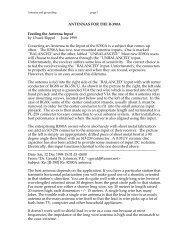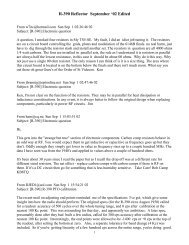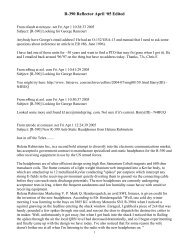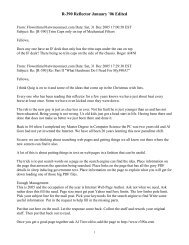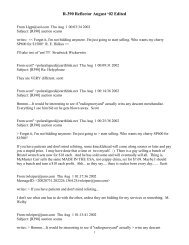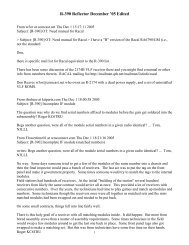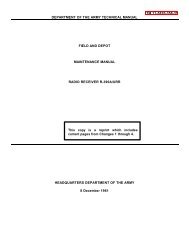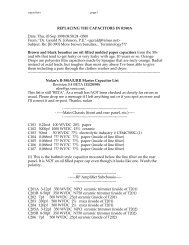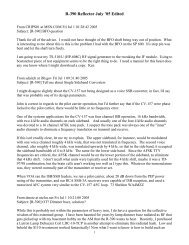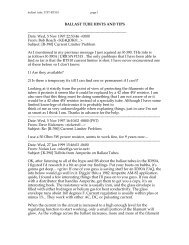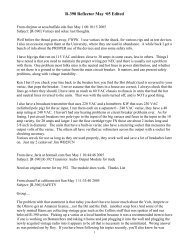Jul - The R-390A Frequently Asked Questions Page
Jul - The R-390A Frequently Asked Questions Page
Jul - The R-390A Frequently Asked Questions Page
You also want an ePaper? Increase the reach of your titles
YUMPU automatically turns print PDFs into web optimized ePapers that Google loves.
Chuck, Hooray. Glad to hear one more of them is back up running again. <strong>The</strong> below comments are<br />
based on modest experience with the "Non-A", and an R-389.<br />
> It would develop a 60 cycle hum ... a 100pf mica cap from one of the > 6082's to ground 900K<br />
resistor. ...theory: the power supply subjected > to further load, would add enough additional stress to<br />
overload the > supply just enough to make it not regulate and hum.<br />
A scope on the 180 volt test jack would reveal such garbage on the B+. Your theory sounds reasonable.<br />
That 100 pF cap keeps noise and garbage off the grids of the 6082 series regulator tubes. If it leaks it<br />
will upset the DC conditions in the regulator amplifier and the regulator might lose control of the<br />
output voltage and hum. Another cap, (C605, I think, 0.22uF) provides ac feedback to reduce B+ hum<br />
and if it leaks the system will not work right. I suggest replacing it if it is suspect. It's also possible that<br />
the 5651 voltage reference tubes are tired and not working well. <strong>The</strong> values of resistors in the voltage<br />
reference and dc feedback amplifier circuits should be checked. Replace any that have drifted. Work<br />
on these components is difficult due to cramped space.<br />
> I will have to come up with some solution to the heat generated by that > module though. A CPU fan<br />
over one of the holes in the side might go far > to help.<br />
Exactly. I strongly recommend a fan be run at all times on that audio/regulator deck. I have made up a<br />
plate that holds a muffin fan against the outside of the radio blowing in. <strong>The</strong> screws from the unused<br />
bottom plate and chassis frame hold it in place. Angle slots at each mounting hole allow the fan to be<br />
slid in place after the radio is put into a rack or cabinet.<br />
A better arrangement would be to mount a fan or fans inside the radio, along with a line bucking<br />
transformer to lower modern high line voltages. Such an added system could include turn-on surge<br />
suppression, a power relay to save the microswitch, line voltage bucking, and fans. <strong>The</strong> Non-A has a<br />
cast frame that offers places to mount such parts with a no-holes approach.<br />
>Found the 1st RF tube replaced with a 6AK5 v/s a 6AJ5 as are all the >oscillator tubes. Also, there is a<br />
6BH6 as the last IF amp.<br />
Possibly another case of mis-guided tube substitution.<br />
>... the filter caps seem to be either papers a-la the 32V-3 HV cap or >are oil filled's.<br />
<strong>The</strong> first and only filter cap in the B+ system is a round oil-paper unit mounted near the front panel on<br />
the audio deck side (C10, I think). It almost never fails. It is at the output of the rectifier stage prior to<br />
the regulator stage. <strong>The</strong> 180 volt output from the 6082 regulator tubes feeds the whole B+ of the radio.<br />
Other than bypass caps such as 0.1 and 0.01 uF, I don't see any other filter caps in the schematic.<br />
NOTE:<br />
<strong>The</strong> DC amplifier tube filament (V607 - 6BH6) is part of a series string. If that tube is not operating the<br />
B+ regulator output will rise to the full unregulated value. This is bad.<br />
Be careful to NOT pull any of these tubes during operation:<br />
V603 V604 V607 V509<br />
6AK6 6AK6 6BH6 6BJ6<br />
(Thanks to Norman Ryan for his list of the Non-A tubes and filament strings.)<br />
28



